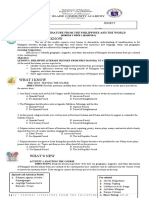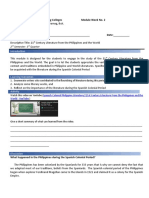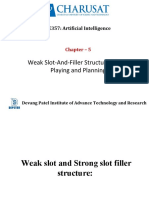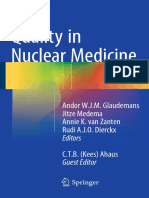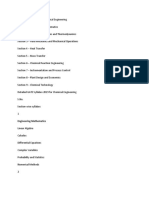Part 1 Les 2
Part 1 Les 2
Uploaded by
Ederlyn Portento CuetoCopyright:
Available Formats
Part 1 Les 2
Part 1 Les 2
Uploaded by
Ederlyn Portento CuetoOriginal Title
Copyright
Available Formats
Share this document
Did you find this document useful?
Is this content inappropriate?
Copyright:
Available Formats
Part 1 Les 2
Part 1 Les 2
Uploaded by
Ederlyn Portento CuetoCopyright:
Available Formats
A COURSE MODULE FOR PHILIPPINE LITERATURE
Lesson 2. Timeline of Philippine Literature and Its Development in English
Learning Objectives
At the end of this module, you should be able to:
1. identify and describe Philippine literature forms in different periods;
2. identify and explain the development of Philippine literature in English;
3. discuss the relationship between literature and history; and
4. make a poster on the importance of studying the timeline of Philippine literature and its
development in English.
Introduction
Literature is a term used to describe written or spoken material. Broadly speaking, "literature"
is used to describe anything from creative writing to more technical or scientific works, but the term
is most used to refer to works of the creative imagination, including works of poetry, drama, fiction,
and nonfiction.
Philippine literature had evolved much before colonization. It is full of legends and tales of
colonial legacy. Mexican and Spanish dominance over the land and the people, over varying periods,
witnessed the incorporation of English, Spanish, Filipino, and native languages, to express ideology
and opinion. Literature in the Philippines developed much later than in most other countries.
Evidence reveals the use of a script called Baybayin that flourished in 1521.
Motive Questions
Directions: Answer the following questions.
1. What is a timeline?
________________________________________________________________________
________________________________________________________________________
2. The _____________ identifies the topic of the timeline.
A. Before Christ B. Era C. Title D. Chronological Order
PART 1: LESSON 2. TIMELINE OF PHILIPPINE LITERATURE AND ITS DEVELOPMENT IN ENGLISH| 7
A COURSE MODULE FOR PHILIPPINE LITERATURE
3. A timeline can represent any length of time.
A. True B. False
4. Should the date on a timeline be spaced properly? For example, 1 inch = 20 years, and 2
inches = 40 years.
A. Yes B. No C. It does not matter if you have the information on the timeline.
5. Can Ad and BCE both be used on the same timeline? Yes, or no? Justify your answer.
________________________________________________________________________
________________________________________________________________________
________________________________________________________________________
________________________________________________________________________
READ
Timelines in Philippine Literature
Pre-Colonial Period (__B.C. to 1564)
The Spanish Regime (1565-1863)
The Nationalistic Period (1864-1896)
The United States Colonial Rule (1910-1930,1920-1945)
The Japanese Occupation (1942-1944)
The Contemporary Period (1960-1986)
Post-Edsa Literature (1986-onwards)
SIGNIFICANT EVENTS IN EACH PERIOD
Pre-Colonial Period (_ B.C. To 1564)
The longest period in Phil. Literature.
PART 1: LESSON 2. TIMELINE OF PHILIPPINE LITERATURE AND ITS DEVELOPMENT IN ENGLISH| 8
A COURSE MODULE FOR PHILIPPINE LITERATURE
The literary outputs of this period cannot be called substantial because much of it was oral
(i.e. tales, songs, riddles, and proverbs.
Riddles- gives an enigma or puzzle.
Proverbs – wise saying or “salawikain”
Songs –a part of pre-colonial literature and the people’s daily life.
Mimetic Dances –often accompanied these songs and rituals and were the precursor of the
drama form.
In prose, pre-colonial literature had myths, tales, fables, legends, and fantastic stories.
Folk epic – the most significant and the longest form of pre-colonial poetry.
Popular Epics: Biag ni Lam-Ang (Ilocos Region), Hinilawod (Panay Island), and Bantugan
and Indarapatra at Sulayman (Maguindanao).
The Spanish Regime (1565-1863)
Christianization of the Philippines
The literary scene during this era was focused on religious themes due to the Christianization
of the Philippines by the Spaniards.
Introduced the first printing press
Doctrina Christiana – the first published book (1593)
Ladinos – they wrote poems in Spanish and Tagalog. They are we-versed in Spanish and
Tagalog.
Pasyon – a long-time narrative poem about the passion and death of Christ. The most
popular form of religious literature.
Ang “Mahal na Pasyon ni Jesu Cristong Panginoon Natin” – is Gaspar Aquilino de Belen’s
well known pasyon.
Sinakulo/Cenakulo – A dramatization of the pasyon. It was performed during Holy Week.
Komedya – the most popular drama form
Prose: “Ang Pagsusulatan ng Dalawang Binibini na si Urbana at Feliza” by Marcelo de
Castro.
Two Popular Narrative Poems:
PART 1: LESSON 2. TIMELINE OF PHILIPPINE LITERATURE AND ITS DEVELOPMENT IN ENGLISH| 9
A COURSE MODULE FOR PHILIPPINE LITERATURE
Awit - it talks about the heroes and their heroic deeds and life. Ex. Florante at
Laura by Francisco Balagtas– the Most Famous Awit
Korido - it talks about faith, legend, and mysteries. It is intended to be sung or
chanted. Ex. Ibong Adarna by Jose De la Cruz.
Other literary forms:
Duplo – Replace the Karagatan. This is a poetic joust in speaking and reasoning.
The roles are taken from the Bible and proverbs and saying. It is usually played
during wakes for the dead.
Karagatan – This is a poetic vehicle of a socio-religious nature celebrated during
the death of a person. In this contest, formal, a ritual is performed based on a legend
about a princess who dropped her ring into the middle of the sea and who offered
her hand in marriage to anyone who can retrieve it. A leader starts with an
extemporaneous poem announcing the purpose. He then spins a “lumbo” o “tabo”
marked with a white line. Whoever comes in the direction of the white line when the
spinning stops gets his turn to “go into the sea to look for the ring.” This means a
girl will ask him a riddle and if he can answer, he will offer the ring to the girl.
The Nationalistic Period (1864-1896)
Nationalism – was the main agenda of this literary period.
The period is divided into PROPAGANDA and REVOLUTION.
At the close of the 19th century, the revolutionist took over and there was a shift not only in
language (from Spanish to Tagalog) but in the audience or readers from the “intelligentsia”
to the “masses.”
• Prop. And Rev. (Rizal, Lopez Jaena & Del Pilar)
The last of the 19th century saw a new breed of writers.
If religion is the thematic focus during the Spanish Era, a strong feeling of nationalism was
the main theme of the nationalistic period.
PART 1: LESSON 2. TIMELINE OF PHILIPPINE LITERATURE AND ITS DEVELOPMENT IN ENGLISH| 10
A COURSE MODULE FOR PHILIPPINE LITERATURE
This period was truly significant because it produced literature that was realistic and truly
Filipino.
Bonifacio, Jacinto and Mabini – the prominent revolutionary writers.
The United States Colonial Rule (1910-1930, 1920-1945)
Literature in three languages flourished: Spanish, English, and Filipino
It was divided into two periods:
• The Period of Apprenticeship
Paz Marquez Benitez (Dead Star)
Paz M. Latorena (The Small Key)
Jose Garcia Villa (Footnote to Youth)
• The Period of Emergence (Before the war or Japanese Occupation)
Some of the noted short story writers are:
Manuel E. Arguila (How my brother Leon brought Home a Wife)
Arturo B. Rotor (The Wound and the Scar and The Men Who Play God)
N.V.M. Gonzales (Seven Hills Away)
Francisco Arcellana (The Flowers of May)
Bienvenido N. Santos (The Transfer)
The Japanese Occupation (1942-1944)
Poets wrote in simple language and free verse.
Portray Filipino Life and Culture through short stories
The Flowering of Tagalog Short Poetry
Palanca Awards/National Awards was launched
PART 1: LESSON 2. TIMELINE OF PHILIPPINE LITERATURE AND ITS DEVELOPMENT IN ENGLISH| 11
A COURSE MODULE FOR PHILIPPINE LITERATURE
This literary period broke away from tradition, especially among Tagalog poets. Instead of
writing in the Balagtas tradition (rhetorical, verbose, figurative), poets wrote in simple
language and free verse. (i.e., “Ako and Daigdig” by Alejandro Abdula)
There was a bountiful harvest in poetry, fiction, and the fields of drama and essay in this
period.
The Contemporary Period (1960-1986)
Upheavals in Nation’s History (First Quarter Storm of the Seventies)
Martial Law Years
Assassination of Ninoy Aquino
A merging of the three traditions:
- Oral Lore –Ethnic Tradition
- Spanish Tradition
- American Colonial Tradition
Literary Expressions
Give responses to the historical and political forces that have shaped Philippine Society
since the Pacific War.
Post-Edsa Literature (1986-__)
The dominant language is largely English and Tagalog-based Filipino.
Another characteristic of post-EDSA writing is the developing thrust toward the retrieval and
recuperation of writing in Philippine languages other than Tagalog.
Post-EDSA publishing has been marked by adventurousness, and a willingness to gamble
on “non-traditional” projects.
PART 1: LESSON 2. TIMELINE OF PHILIPPINE LITERATURE AND ITS DEVELOPMENT IN ENGLISH| 12
A COURSE MODULE FOR PHILIPPINE LITERATURE
Activity 1: Foldable Timeline
Directions: Make a foldable timeline of the “Timeline of the Philippine Literature. Make sure you have
the date on part of the fold, and then under it illustrate the event. The description of the event is to
the right of the date. Glued your work in the box below.
*Please see the attached rubric or criteria for checking on the last page.
PART 1: LESSON 2. TIMELINE OF PHILIPPINE LITERATURE AND ITS DEVELOPMENT IN ENGLISH| 13
A COURSE MODULE FOR PHILIPPINE LITERATURE
Development/ Periods of Philippine Literature in English
Period of Orientation (1898-1910)
Period of Imitation (1910-1924)
Period of Growth and Experimentation (1925-1941)
Period of Propaganda (1942-1944)
Post-Liberation Period (1945-onwards)
SIGNIFICANT EVENTS IN EACH PERIOD
The Period of Orientation (1898-1909)
It began with the Occupation of Manila by the American forces on August 13, 1898.
It extended to the publication of the College Folio in 1910.
College Folio in 1910- it is when the Filipino writers made their first attempts at expression
in the new language.
It consisted mostly of articles dealing with patriotism and nationalism.
Only El Renacimiento and the Free Press published writings in English.
The nationalistic and rebellious spirit against the American occupation also found expression
in Filipino literature in English of this period.
The Period of Imitation (1910-1924)
It began in 1910 when the College Folio made its appearance at the University of the
Philippines.
Filipino writers start using the English language in writing.
This period was characterized by strict adherence to the conventional forms of literature and
by careful observance of the rules of grammar and rhetoric.
Conventional forms of literature as exemplified in the works of Longfellow, Hawthorne,
Emerson, Tennyson, Thackerey, and Macaulay.
PART 1: LESSON 2. TIMELINE OF PHILIPPINE LITERATURE AND ITS DEVELOPMENT IN ENGLISH| 14
A COURSE MODULE FOR PHILIPPINE LITERATURE
The publication of magazines and newspapers in English gave budding writers a chance to
see their compositions in print. For example, Philippine Review, Independent, Rising
Philippines, and Citizens, in addition to the Philippine Collegian, the UP-student organ.
The Philippines Herald became the pioneer Filipino newspaper in English in 1920.
Paz Marquez Benitez gained some measure of mastery far ahead of the period as
exemplified in her short story “Dead Star.”
• Dead Star - was, for a long time, considered “a model of perfection in character
delineation, local color, plot, and message.
• Local color - interesting characteristic features: unusual or traditional features of
a particular place that make it interesting
The first book of poems and the first novel in English written by a Filipino were published
during this period Procopio Solidum’s Never Mind and Other Poems and Zoilo M. Galang’s
A Child of Sorrow.
• Zoilo’s A Child of sorrow uses very ornate language. (mabulaklak na salita)
Period of Growth and Experimentation (1925-1941)
Filipino writers mastered, not only the fundamentals but also the nuances of the English
language sufficiently to be able to write in it with more confidence.
They tried all forms of writing including the novel and drama.
Some critics considered this period from 1930 until 1940 as the Golden Era of Filipino writing
in English.
A deep attachment to the soil and a strong spirit of liberalism took possession of the writers.
A deep spirit to the soil.
Jose Garcia Villa (aka Doveglion) excelled as a critic, short story writer, and poet and
tremendously influenced Filipino writing.
Marcelo de Gracia Concepcion’s “Azucena” became the first book of Filipino verse to be
printed in America.
Several of short story writers arrived with Villa – Manuel Argulla, Paz latorena, Loreto Paras,
Arturo B. Rotor, and Alfredo E. Litiaco.
PART 1: LESSON 2. TIMELINE OF PHILIPPINE LITERATURE AND ITS DEVELOPMENT IN ENGLISH| 15
A COURSE MODULE FOR PHILIPPINE LITERATURE
Filipino writers were also influenced by Sherwood Anderson, Ernest Hemingway, William
Saroyan, and Dorothy Parker.
Other poets were Amador T. Daguio, Angela Manalang Gloria, and Luis Dato.
In 1940, through the initiative and efforts of the Philippine Writers’ League, the
Commonwealth Government started a yearly literary contest.
The first Filipino biographer to write in English is Carlos Quirino with his “The Great
Malayan.” “Mallari’s The Birth of Discontent” showed the mastery of the art of irony as well
as of the English Language.
In the essay, the notable writings included Salvador P. Lopez’s prize-winning collection
“Literature and Society” and Francisco P. Icasiano’s “Horizons from my Nipa Hut.”
Filipino playwrights flourished during this period: Augusto C. Cantanjal (The Oil Lamp), Vidal
A. Tan (The Husband of Mrs. Cruz), Severino Montano (The Land of our Fathers), and
Wilfrido Ma. Guerero (13 Plays), became the most prolific dramatist.
Period of Propaganda (1942-1944)
The war year – WWII
The war dampened the literary enthusiasm of the preceding period.
The writings of this period were largely journalistic, and the literary output was negligible for
two reasons: (1) it was, in the main, insincere, and (2) there was very little opportunity for
publication.
This period saw the rise of Carlos P. Romulo.
Carlos P. Romulo – the first Filipino writer and journalist to win international recognition. He
won the Pulitzer Prize, and his “I Saw the Fall of the Philippines,” “I See the Philippine Rise,”
and “Mother America” became the best seller.
Post-Liberation Period (1945-onwards)
The most significant achievement of this period was the recognition afforded to Filipino
writers abroad.
The militancy which might be expected because of the war was very evident among
journalists and editors.
PART 1: LESSON 2. TIMELINE OF PHILIPPINE LITERATURE AND ITS DEVELOPMENT IN ENGLISH| 16
A COURSE MODULE FOR PHILIPPINE LITERATURE
Carlos Bulosan –put a book of poems called “Voice of Bataan” immediately after the
outbreak of WWII. This volume was followed by “The Laughter of My Father,” and America
is in the Heart.”
• The Laughter of my Father is a collection of humorous short stories.
• America is in the Heart sometimes subtitled as a personal History is an
autobiography.
Stevan Javellana -published his novel “Without Seeing the Dawn.”
• Without Seeing a Dawn is a war novel comparable to Rizal’s masterpieces.
Jose Garcia Villa’s collection of poems “Have Come, Am Here” revealed great power both
in thought and expression and elicited the warmest praises from American and English
critics.
Activity 2: Foldable Timeline
Directions: Make another foldable timeline of the topic “Development of Philippine Literature in
English.” Make sure you have the date on part of the fold, and then under it illustrate the event. The
description of the event is to the right of the date. Glued your work in the box below.
**Please see the attached rubric or criteria for checking on the last page.
PART 1: LESSON 2. TIMELINE OF PHILIPPINE LITERATURE AND ITS DEVELOPMENT IN ENGLISH| 17
A COURSE MODULE FOR PHILIPPINE LITERATURE
Culminating Activity 1
Directions: Answer the given question.
1. What is the relationship between literature and history? Elaborate on your answer.
______________________________________________________________________________
______________________________________________________________________________
______________________________________________________________________________
______________________________________________________________________________
______________________________________________________________________________
______________________________________________________________________________
______________________________________________________________________________
______________________________________________________________________________
______________________________________________________________________________
______________________________________________________________________________
______________________________________________________________________________
______________________________________________________________________________
______________________________________________________________________________
______________________________________________________________________________
______________________________________________________________________________
______________________________________________________________________________
______________________________________________________________________________
______________________________________________________________________________
______________________________________________________________________________
______________________________________________________________________________
______________________________________________________________________________
______________________________________________________________________________
______________________________________________________________________________
______________________________________________________________________________
**Please see the attached rubric or criteria for checking on the last page.
PART 1: LESSON 2. TIMELINE OF PHILIPPINE LITERATURE AND ITS DEVELOPMENT IN ENGLISH| 18
A COURSE MODULE FOR PHILIPPINE LITERATURE
Culminating Activity 2
Directions: Made a poster about the importance of studying the timeline of Philippine Literature and
its development in English.
**Please see the attached rubric or criteria for checking on the last page.
PART 1: LESSON 2. TIMELINE OF PHILIPPINE LITERATURE AND ITS DEVELOPMENT IN ENGLISH| 19
A COURSE MODULE FOR PHILIPPINE LITERATURE
References:
Lacia, Ferdilyn, C., et al. (3rd Ed.), (2015). The Literatures of the Philippines. Quezon City, Metro
Manila, Philippines: Rex Book Store, Inc.
Saymo, A. S. (2014). Philippine Literature. Manila, Philippines: Erehwon Artworld Corporation
Ang, J. G. (2012). Literature 101 (Philippine Literature: A Course Reader). Manila, Philippines:
Mindshapers Co., Inc.
Marco, L.L. et al. (2009). Philippine Literary Heritage (from Spanish Period to Present). Manila,
Philippines: Mindshapers Co., Inc.
PNU Reviewer: General Education. (2019)
Rubrics/ Criteria for Grading
Rubric for Activity 1 & 2. Foldable Timeline
Completion - 4 points
Content - 5 points
Presentation - 6 points
15 points
Rubric for Culminating Activity 1. Essay
Focus and Details - 1 point
Organization - 1.5 point/s
Voice - 1.5 point/s
Word Choice - 3 points
Sentence Structure, Grammar, Mechanics, & Spelling - 3 points
10 points
PART 1: LESSON 2. TIMELINE OF PHILIPPINE LITERATURE AND ITS DEVELOPMENT IN ENGLISH| 20
A COURSE MODULE FOR PHILIPPINE LITERATURE
Rubric for Culminating Activity 2. Poster
Visual Clarity and Appeal - 6 points -
Message/Content - 8 points
Presentation - 6 points
20 points
PART 1: LESSON 2. TIMELINE OF PHILIPPINE LITERATURE AND ITS DEVELOPMENT IN ENGLISH| 21
You might also like
- Watchtower: Examining The Scriptures Daily - Daily Text Booklet - Large Print - 2015Document129 pagesWatchtower: Examining The Scriptures Daily - Daily Text Booklet - Large Print - 2015sirjsslutNo ratings yet
- Timelines in Philippine LiteraturesDocument21 pagesTimelines in Philippine LiteraturesChristian JP Lijayan Robertson100% (1)
- 21 Century Literature From The Philippines and The World: SHS Grade 11/12Document20 pages21 Century Literature From The Philippines and The World: SHS Grade 11/12Faharnia DisomnongNo ratings yet
- Philippine Literature From The Pre Colonial Period To The Contemporary - PPTX 20240624 210730 0000Document85 pagesPhilippine Literature From The Pre Colonial Period To The Contemporary - PPTX 20240624 210730 0000lalaineaquino004No ratings yet
- Week 1Document37 pagesWeek 1RN DiazNo ratings yet
- LAS #1 21st Century Literature From The Philippines and The World LASDocument17 pagesLAS #1 21st Century Literature From The Philippines and The World LASAlbert Ventero CursodNo ratings yet
- Senior High School-21 Century Literature Teaching From The Philippines To The WorldDocument6 pagesSenior High School-21 Century Literature Teaching From The Philippines To The WorldCalyn Isidoro100% (1)
- Prepared Module For 21ST W1Q1Document7 pagesPrepared Module For 21ST W1Q1Lielanie NavarroNo ratings yet
- Commencement Prayer:: Poblacion, Puerto Galera, Oriental MindoroDocument7 pagesCommencement Prayer:: Poblacion, Puerto Galera, Oriental Mindorocamille datingalingNo ratings yet
- 21st Century Literatures PPT Q1Document33 pages21st Century Literatures PPT Q1balabajudymaeNo ratings yet
- Short Saying That Gives Advice or Expresses TruthDocument5 pagesShort Saying That Gives Advice or Expresses Truthramon discionNo ratings yet
- History of Phil LitDocument35 pagesHistory of Phil LitGabriel SuguitanNo ratings yet
- 21 Century From The Philippines and The World Quarter 1 - Module 1: Geographic, Linguistic and Ethnic Dimensions of Philippine LiteraryDocument6 pages21 Century From The Philippines and The World Quarter 1 - Module 1: Geographic, Linguistic and Ethnic Dimensions of Philippine LiteraryNico Paolo L. BaltazarNo ratings yet
- Lesson 4 5 Philippine LiteratureDocument9 pagesLesson 4 5 Philippine LiteratureMoniqueNo ratings yet
- Senior High School-21 Century Literature Teaching From The Philippines To The WorldDocument7 pagesSenior High School-21 Century Literature Teaching From The Philippines To The WorldMichelle EstavilloNo ratings yet
- ReviewerDocument37 pagesReviewerlerkhe toribioNo ratings yet
- 21st Century Literature From The Philippines and The World - Module 1Document5 pages21st Century Literature From The Philippines and The World - Module 1gean0% (1)
- LiteratureDocument4 pagesLiteratureSheian MirandaNo ratings yet
- Geographic, Linguistic, and Ethnic Dimensions of Philippine Literary HistoryDocument26 pagesGeographic, Linguistic, and Ethnic Dimensions of Philippine Literary HistoryGemaris Laurenaria MercadoNo ratings yet
- Villanueva Rejean Y. - 1 BSE-E SOC ST - LIT 111 A - LESSON 3Document9 pagesVillanueva Rejean Y. - 1 BSE-E SOC ST - LIT 111 A - LESSON 3Rejean Yap VillanuevaNo ratings yet
- Lesson III 1Document17 pagesLesson III 1Charllote OperioNo ratings yet
- 3_HISTORY-OF-PHIL-LIT(2)Document35 pages3_HISTORY-OF-PHIL-LIT(2)rebites14No ratings yet
- Prepared By: Nowell P. TorrejasDocument24 pagesPrepared By: Nowell P. TorrejasSophia Nicole DemoniseNo ratings yet
- M2. 21st Century Lit Phil and WorldDocument6 pagesM2. 21st Century Lit Phil and WorldErickson SongcalNo ratings yet
- 21st Century Literature Activity Sheet 02 - Spanish LiteratureDocument4 pages21st Century Literature Activity Sheet 02 - Spanish LiteratureIanne Violet Yumierre TabañagNo ratings yet
- SoftDocument40 pagesSoftjohn kenneth bayangosNo ratings yet
- 21st Century Literature Activity Sheet 02 - Spanish LiteratureDocument4 pages21st Century Literature Activity Sheet 02 - Spanish LiteratureYouie ChyrreNo ratings yet
- 21st Century Literature Week 1Document16 pages21st Century Literature Week 1Andrei John RamosNo ratings yet
- 21ST CenturyDocument5 pages21ST Centurylafuenteamelie4No ratings yet
- 21st Century L1 L2 ReviewerDocument11 pages21st Century L1 L2 ReviewerNana MinNo ratings yet
- PhilLit-Lesson3 (Historical Background of Philippine Literature)Document36 pagesPhilLit-Lesson3 (Historical Background of Philippine Literature)Ella Marie MacasaetNo ratings yet
- Lesson 1 2 1st Century Literaturefinal PPT 1Document31 pagesLesson 1 2 1st Century Literaturefinal PPT 1Kring G. Quisay100% (1)
- 21st Century Literature Lesson 1 GRADE 12 STEMDocument3 pages21st Century Literature Lesson 1 GRADE 12 STEMjeromejorgioNo ratings yet
- 21ST Cent. Phil. Lit. Lesoon 1-3Document72 pages21ST Cent. Phil. Lit. Lesoon 1-3Mika Patricia Dela CruzNo ratings yet
- History of Philippine LiteratureDocument8 pagesHistory of Philippine LiteratureNorhata Maguid SapalNo ratings yet
- Geographic, Linguistic, and Ethnic Dimensions of Philippine Literary HistoryDocument23 pagesGeographic, Linguistic, and Ethnic Dimensions of Philippine Literary HistoryMarie Grace TaghapNo ratings yet
- Concept Notes On Literary History With Literary DimensionsDocument10 pagesConcept Notes On Literary History With Literary DimensionsLemuel Ian Batiller Cua50% (2)
- Lesson: The Journey of Philippine Literature: From Precolonial To Contemporary PeriodDocument10 pagesLesson: The Journey of Philippine Literature: From Precolonial To Contemporary PeriodHiraeth AlejandroNo ratings yet
- 21 Century Literature From The World and The PhilippinesDocument13 pages21 Century Literature From The World and The PhilippinesRutchelNo ratings yet
- 21st Century Lesson 1Document63 pages21st Century Lesson 1princessrvymatiasNo ratings yet
- 21st Century - Week 1Document37 pages21st Century - Week 1Michelle Devera100% (1)
- 21st Century Lit Q1 Wk1Document28 pages21st Century Lit Q1 Wk1keshalala alonNo ratings yet
- Pre Colonial To Revolutionary EN7Document5 pagesPre Colonial To Revolutionary EN7mamu chabeNo ratings yet
- 21 Century Literature From The Philippines and The World: Module inDocument21 pages21 Century Literature From The Philippines and The World: Module inNoelyn Flores100% (2)
- Graphical TimelineDocument10 pagesGraphical TimelineraymarkpillosNo ratings yet
- 21ST Century Midterms ReviewerDocument6 pages21ST Century Midterms ReviewerKate JavierNo ratings yet
- 21St Century Literature Grade 12Document14 pages21St Century Literature Grade 12Japeth NaborNo ratings yet
- 6 LP 21st Century LiteratureDocument57 pages6 LP 21st Century LiteratureLorry DoronNo ratings yet
- Different Periods of Philippine LiteratureDocument17 pagesDifferent Periods of Philippine LiteraturePrincess Canceran BulanNo ratings yet
- Periods of Philippine LiteratureDocument76 pagesPeriods of Philippine LiteratureJefry Cardinoza100% (1)
- Reviewer On 21ST Century Literature (Timeline)Document6 pagesReviewer On 21ST Century Literature (Timeline)Jean DaclesNo ratings yet
- 5 21st Century LIT ACTIVITYDocument54 pages5 21st Century LIT ACTIVITYLorry DoronNo ratings yet
- Reviewer in 21st Century Literature From The Philippines and The WorldDocument2 pagesReviewer in 21st Century Literature From The Philippines and The WorldvarNo ratings yet
- Q1 Module 1 Week 1 & 2-PERIODS OF LITEARTUREDocument4 pagesQ1 Module 1 Week 1 & 2-PERIODS OF LITEARTUREClare SiplonNo ratings yet
- 21st Century LiteratureDocument56 pages21st Century LiteratureEli NavalNo ratings yet
- Module 1 21st Century Literature From The Philippines and The WorldDocument7 pagesModule 1 21st Century Literature From The Philippines and The WorldShopia IbasitasNo ratings yet
- 21st Century Literature Modules CompilationDocument61 pages21st Century Literature Modules CompilationKarlo Louis DongonNo ratings yet
- Overview of Unit 1Document14 pagesOverview of Unit 1SAMNo ratings yet
- Philippine Literature History Timeline: Historical EventsDocument11 pagesPhilippine Literature History Timeline: Historical EventsRedenRosuenaGabrielNo ratings yet
- Writing to Cuba: Filibustering and Cuban Exiles in the United StatesFrom EverandWriting to Cuba: Filibustering and Cuban Exiles in the United StatesNo ratings yet
- The Woman Who Had Two Navels and Tales of the Tropical GothicFrom EverandThe Woman Who Had Two Navels and Tales of the Tropical GothicRating: 4.5 out of 5 stars4.5/5 (3)
- DLA-Vessels Guide E-Feb14 PDFDocument68 pagesDLA-Vessels Guide E-Feb14 PDFAnonymous xPBUKuVsj4No ratings yet
- Statistics Final ExaminationDocument2 pagesStatistics Final Examinationmartinelli ladoresNo ratings yet
- Engineering Structures: Pengpeng Ni, Sujith Mangalathu, Guoxiong Mei, Yanlin ZhaoDocument12 pagesEngineering Structures: Pengpeng Ni, Sujith Mangalathu, Guoxiong Mei, Yanlin ZhaoManaswini VadlamaniNo ratings yet
- Julius Vs Augustus PowerpointDocument6 pagesJulius Vs Augustus Powerpointapi-235829468No ratings yet
- Sentence Type Basics For EnglishDocument25 pagesSentence Type Basics For EnglishAnisah Abd AzizNo ratings yet
- JR ResumeDocument1 pageJR ResumeRico SuaveyNo ratings yet
- Saeed BookDocument4 pagesSaeed BookAruba KhanNo ratings yet
- Alglib ManDocument430 pagesAlglib ManStanley KoNo ratings yet
- Emotional Engineering, Vol. 6: Shuichi Fukuda EditorDocument153 pagesEmotional Engineering, Vol. 6: Shuichi Fukuda EditorBenja Rodriguez LNo ratings yet
- DRDFGYJBHDocument5 pagesDRDFGYJBHmarie joyce almayanNo ratings yet
- Lesson-Reference OC11 1stMT WK1Document16 pagesLesson-Reference OC11 1stMT WK1rte9566No ratings yet
- Meralco Vs Wilcon BuildersDocument2 pagesMeralco Vs Wilcon BuildersBAROPSNo ratings yet
- Aisha Steel Annual Report 2015Document114 pagesAisha Steel Annual Report 2015Anonymous bagPio3No ratings yet
- Weak Slot-And-Filler Structure, Game Playing and PlanningDocument21 pagesWeak Slot-And-Filler Structure, Game Playing and PlanningKISHAN MALAVIYANo ratings yet
- Design Failure Modes and Effects Analysis (DFMEA) of Self Propelled Onion Harvester (TIFAN Vehicle)Document13 pagesDesign Failure Modes and Effects Analysis (DFMEA) of Self Propelled Onion Harvester (TIFAN Vehicle)IJRASETPublicationsNo ratings yet
- Bridgeport - j1 - Head - 2 - 0 - 01 Rebuild-10 PDFDocument69 pagesBridgeport - j1 - Head - 2 - 0 - 01 Rebuild-10 PDFcbr6000100% (4)
- W2.19. Regala v. Manila Hotel GR 204684, October 5, 2020Document13 pagesW2.19. Regala v. Manila Hotel GR 204684, October 5, 2020noemi alvarezNo ratings yet
- Inca Social StructureDocument19 pagesInca Social StructureRebecca Hefter CarmonaNo ratings yet
- Blue Sparrow: Tweets On Writing, Reading, and Other Creative NonsenseDocument143 pagesBlue Sparrow: Tweets On Writing, Reading, and Other Creative NonsenseKsenia AnskeNo ratings yet
- The Effects of Loyalty Programs On Profits and Customer RetentionDocument17 pagesThe Effects of Loyalty Programs On Profits and Customer RetentionPragati GothiNo ratings yet
- Book Review Presentation (The Monk Who Sold His Ferrari)Document13 pagesBook Review Presentation (The Monk Who Sold His Ferrari)abhi00009100% (4)
- 944 Type Training Logbook PDFDocument17 pages944 Type Training Logbook PDFTrần Triệu PhongNo ratings yet
- 2017 Book QualityInNuclearMedicineDocument455 pages2017 Book QualityInNuclearMedicineHarley Alejo MNo ratings yet
- Gate Chemical Engineering SyllabusDocument3 pagesGate Chemical Engineering SyllabusSatti Subrahmanyam ReddyNo ratings yet
- ECA2+ Tests Language Test 7B 2018Document5 pagesECA2+ Tests Language Test 7B 2018Cubi ArtNo ratings yet
- Positive MidtermDocument7 pagesPositive MidtermShuyao LiNo ratings yet
- Grade 10 ReviewerDocument2 pagesGrade 10 ReviewerLanie De la TorreNo ratings yet
- Elite: All Short StoriesDocument38 pagesElite: All Short StoriesaltNoctsNo ratings yet
- Research Notes Chapter 2Document14 pagesResearch Notes Chapter 2Andrea de la SernaNo ratings yet







